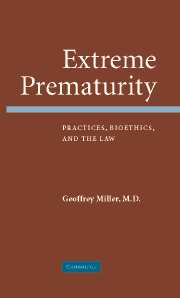Book contents
- Frontmatter
- Contents
- Part 1 THE EXTREMELY PRETERM INFANT: EPIDEMIOLOGY, PERCEPTIONS, AND PRACTICES
- Part 2 BIOETHICS
- 14 Moral Theory
- 15 Autonomy
- 16 Beneficence and Nonmaleficence
- 17 Justice
- 18 Sanctity of Life
- 19 Active and Passive Euthanasia
- 20 Personhood
- 21 Quality of Life and Best Interests
- 22 Futility
- Part 3 REPORTS, OFFICIAL OPINIONS, AND GUIDELINES
- Part 4 THE LAW
- Part 5 EPILOGUE: TRUTH, TRUST, AND BOUNDARIES
- References
- Index
16 - Beneficence and Nonmaleficence
Published online by Cambridge University Press: 23 September 2009
- Frontmatter
- Contents
- Part 1 THE EXTREMELY PRETERM INFANT: EPIDEMIOLOGY, PERCEPTIONS, AND PRACTICES
- Part 2 BIOETHICS
- 14 Moral Theory
- 15 Autonomy
- 16 Beneficence and Nonmaleficence
- 17 Justice
- 18 Sanctity of Life
- 19 Active and Passive Euthanasia
- 20 Personhood
- 21 Quality of Life and Best Interests
- 22 Futility
- Part 3 REPORTS, OFFICIAL OPINIONS, AND GUIDELINES
- Part 4 THE LAW
- Part 5 EPILOGUE: TRUTH, TRUST, AND BOUNDARIES
- References
- Index
Summary
From classical times health care professionals have been obliged to avoid harming their patients and to promote their welfare. But in the medical and surgical management of preterm infants harm is often inflicted that is considered justified because of the presumed benefits. The harm may be relatively minor, such as taking blood samples or placing intravenous lines, or it may have the potential to cause long-term damage, such as with prolonged high pressure artificial ventilation or the surgical removal of bowel damaged by necrotizing enterocolitis. At what point does treatment no longer offer a benefit? Some may argue that a supposed long-term benefit, for example, survival, may not further the welfare of the infant, the family, or society. This argument might arise when it is proposed to place a ventriculo-peritoneal shunt into a severely brain-damaged preterm infant with progressive posthemorrhagic hydrocephalus. In all aspects of health care there is a balance between beneficence and nonmaleficence. The principle of nonmaleficence would support foregoing treatment if it was of no benefit and the treatment would inflict harm and suffering. But the use of the principle correctly requires that lack of benefit, harm, and suffering can be recognized and predicted. The principle of beneficence would support an action, or lack thereof, if it was in the best interests of the infant. Correct use of the principle requires that it is understood what interests the infant has, or perhaps will have, from the perspective of the infant.
- Type
- Chapter
- Information
- Extreme PrematurityPractices, Bioethics and the Law, pp. 62 - 67Publisher: Cambridge University PressPrint publication year: 2006



